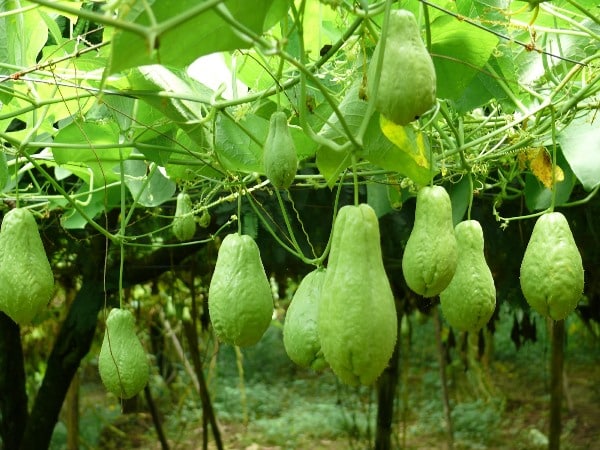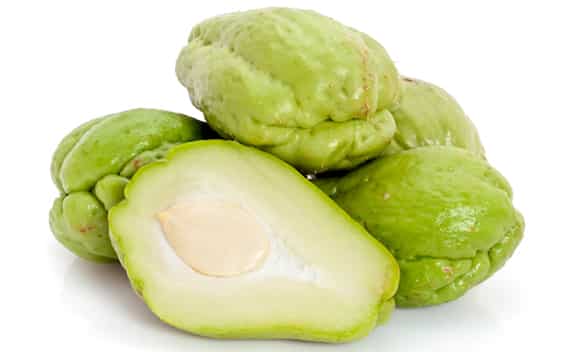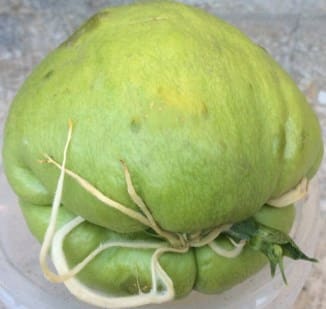Chow Chow Vegetable Farming Guide:
Introduction of Chow Chow Vegetable Farming:- Chow chow is one of the edible perennial plants belonging to the gourd family Cucurbitaceae, along with melons, cucumbers and squash. Chow chow is also known with different names like chayote summer squash, cho-cho. The plant looks similar to Ridge gourd/ Bottle gourd plants. Chow chow fruit is roughly pear-shaped, somewhat flattened and with coarse wrinkles and it can range from 10 to 15 cm in length. This vegetable is used in pickles and sambar in south India. In addition to fruit, stem, tender leaves and tuberous roots are also eaten. Chow chow has great nutritional values and has good health benefits. This plant can be grown in backyards, containers, pots and greenhouses/ polyhouses / shade nets. The following article details about growing chow chow vegetable.

Family Name of Chow Chow Vegetable:- Cucurbitaceae.
Botanical/Scientific Name of Chow Chow Vegetable:- Sechium edule.
Genus of Chow Chow Vegetable:- Sechium.
Health Benefits of Chow Chow Vegetable:- Some of the health benefits of Choyate or Chow Chow vegetables are given below.

- Chow Chow vegetables are good source of Vitamin ‘C’, Fiber & trace minerals.
- Chow Chow vegetables may prevent from certain types of cancers.
- Chow Chow vegetables help preventing constipation.
- Chow Chow vegetables are good for thyroid health.
- Chow Chow vegetables help in preventing acne.
- Chow Chow vegetables help in preventing bone loss.
- Chow Chow vegetables are good for heart health.
- Chow Chow vegetables are good for reducing leg cramps.
- Chow Chow vegetables good for brain function.
- Chow Chow vegetables help in reducing blood pressure.
- Chow Chow vegetables have anti-inflammatory properties.
- Chow Chow vegetables aid weight loss.
- Chow Chow vegetables help in preventing kidney stones.
- Chow Chow vegetables help in preventing anemia.
- Chow Chow vegetables may prevent from birth defects.
- Chow Chow vegetables help lower cholesterol levels.
- Chow Chow vegetables have anti-aging properties.
- Chow Chow Vegetables also helpful in preventing bloating.
Common Names of Chow Chow Vegetable:- Chayote, Chow-Chow, Chayote Squash, Pear squash, Vegetable Pear, Cho-Cho, Bengaluru venkaaya. It is also called as Ishkus in Dargiling, Launkdu in Himachal Pradseh, Das Goos, Gussii in Manipur, Iskut in Mizoram.
Indian Names of Chow Chow Vegetable:- Chayote or Chow-Chow (Hindi), Seema Vankaya (Telugu), Seemai Kathirikai (Tamil), Seeme Bhadhare Kai (Kannada), Phuti Kakudi (Oriya), Bangalore Kathrikka/ Sheema Kathrikka (Malayalam), Chayote (Marathi).
Varieties (Cultivars) of Chow Chow Vegetable:- There are mainly two varieties of Choyate vegetables are available; white and green. However, there is no specific improved or commercial variety released in India, There are some high yielding genotypes which can produce up to 35 to 40 kg per plant. Broad Green, Pointed Green and Oval Green are some of the types recommended for best quality and yield . There two cultivars (varieties) released outside India are Florida Green & Monticello White.
Climate Requirement for Chow Chow Vegetable Farming:- These vegetables can be grown up to 1500 meter (msl- mean sea level) altitudes. We can say it is a warm season crop can be grown in both tropical and sub-tropical regions. The ideal temperature for best fruit growth is 30 °C. The chow chow vine can grow under full sun to mild shaded conditions. Generally, fruits exposed to sunlight are yellowish in colour and vines grown under shade produce dark green fruits (vegetables). Chow-Chow thrives well in moderate climate with high humidity conditions. These vegetables grow well in north Indian eastern regions as these conditions more prevalent there. This crop does not survive in extreme dry wind during summer. Frost conditions in winter should be avoided as this crop is very sensitive to frost.
Soil Requirement of Chow Chow Vegetable Farming:- This crop requires well- drained and loose fertile soil for high yields. Soils that are rich in organic matters should be selected for commercial chow chow farming. Though all the cucurbits are sensitive to soils having pH value of 5.5, chow-chow crop is slightly tolerant to acidic soils (below pH of 5.5). So the Ideal soil pH is between 5.5 to 6.5. Soil depth one of major factor that influences the crop as this plant is perennial and has to support vines up to 3 years period. Pit planting for growing this vegetable on trellis should be adopted as it supports the chow-chow vines for a longer period of time. Commercial vegetable growers should go for soil testing and any soil fertile deficiencies can be incorporated based on the soil test results.
Propagation in Chow Chow Vegetable Farming:- Propagation of chow-chow vegetables are done by seeds (whole fruit/vegetable is planted as seed).

Land Preparation in Chow Chow Vegetable Farming:- Land should be given 3 to 4 deep ploughings with local tractor disc. Remove any weeds from previous crops and level the land in such a way that there won’t be any water stagnation in the field in case of heavy rains. To make soil rich in organic matter, add 20 to 25 tons/ha of well- decomposed farm yard manure (FMY) like cow dung during the last plough. This crop can be grown just like Bottle gourd / Bitter gourd / Ridge gourd / Cucumber
Seed Rate, Planting, and Spacing in Chow Chow Vegetable Farming:- Usually, planting of chow-chow vegetables is done during rainy season. However, with available irrigation, it can be grown throughout out the year. You can adopt controlled environments like greenhouse / polyhouse / shade net for growing this vegetable commercially all around the year. Dig pits of size 0.5 meter x 0.5 meter x O.5 meter and add 1/3 of well-rotten farm yard manure (FYM) to the soil and fill the pits with this mix. Fully matured and sprouted fruits / vegetables should be collected from high yielding vines and planted directly on centre of the pits (can plant 2 to 3 sprouted fruits/pit). Spacing of plants should be maintained at 6 feet x 9 feet. When it comes to seed rate, it depends on the soil and variety, on an average 1500 to 1600 sprouted vegetables/ha are required.
Irrigation in Chow Chow Vegetable Farming:- Timely irrigation especially in dry season is very important. Rain fed crops doesn’t require any irrigation. However, constant moisture conditions are required for good growth. The frequency of irrigations depends on soil type and climatic conditions. Flowering and fruiting stages are very important and any water stress should be avoided. Drip irrigation can be adopted for proper utilization of water and fertilizers. This can also limit the weed growth at plant base. Mulching can be practiced to prevent the moisture loss and to check the weeds.
Manures and Fertilizers in Chow Chow Vegetable Farming:- Applying Manures and fertilizers in chow-chow plants at right time is essential for healthy growth and quality produce. As we said earlier, 20 to 25 tons of farm yard manure (FMY) should be supplemented in the soil during land preparation. N: P: K at the rate of 120:80:80 kg/ha should be applied with full dose of ‘P’ & ‘K’ before sowing the seed and 1/2 dose of ‘N’ should be applied at the time of vining. Remaining 1/2 dose of ‘N’ should be applied before flowering.
Intercultural Operations in Chow Chow Vegetable Farming:- The following intercultural operations should be practiced in chow-chow plantation.
- Weed Control: Weed free field is important for healthy crop and yield. Though there are many herbicide/weedicides available, I personally suggest thinking of any natural weed controls like mulching. Remove dried leaves and branches on periodic basis.
- Training: As this plant is grows like a vine, it has to have proper support for growth. Pandals or trellis can be used for the vines to trail over at a height of 2 meters. The plant vines can also allowed climbing on small trees. These trellis usually constructed with bamboo sticks. Bower can also be prepared at the height of 5 ft. placing bamboo poles followed by criss-cross wire netting. Training on bower must be started just after 30 cm of vine length from the ground level.
- Pruning: There are 2 fruiting seasons in a year and vines should be pruned at end of each season leaving only a small portion of about 1.5 meter of stem on the plant.
Pests and Diseases in Chow Chow Vegetable Farming:- The following are the pests and disease found in Chow Chow Vegetable Farming.
- Pests: Fruit fly, scales, mealy bugs and aphids are common pests found in chow-chow plantation.
- Control Measures: To control scales, mealy bugs and aphids, spray Dimethoate 30 EC @ 1 ml/liter water. To control fruit fly, destroy the effected fruits. Sowing time can be adjusted to control this.
- Diseases: Mosaic, powdery mildew and downy mildew are some diseases found in chow chow plantation.
- Control Measures: Spray Methyl demeton 25 EC 2 ml/liter water thrice at fortnightly intervals to control mosaic disease. To control powdery mildew, spray Bavistin @ 1 gram/liter of water at least thrice @ 5 to 6 days interval. To control downy mildew, fungal spray of Dithane M-45 (0.2%) once a week is effective in controlling this.
Note: It is always advised to contact your local horticulture department for symptoms of diseases and pests and their control measures in Chow Chow Vegetable Farming.
Harvesting in Chow Chow Vegetable Farming:- Chow-chow vegetables should not be allowed to become over mature and pick the vegetables prior to seed development.
Yield in Chow Chow Vegetable Farming:- Yield of crop depends on many factors such as variety, soil, plant age, climate and garden management practices. Under ideal farming conditions, one can obtain an average yield up 80 to 100 quintals/acre. The crop is semi-perennial and can cast up to 2 to 3 years.
How to Get Chow Chow Vegetable Seeds:- You can get them from good standard nurseries and even can purchase online. However, I don’t prefer to buy online as there is no guaranty of sprouting and germination percentage may be very less.
Marketing of Chow Chow Vegetables:- Fresh vegetables can be picked and marketed to local vegetable markets. You can even sell these at farm gate. Vegetable suppliers/agents are best point of contact for bulk marketing.
Bottom Line of Chow Chow Vegetable Farming:- Commercial cultivation of chow -chow vegetables in all over India picking up after the greenhouse / polyhouse / shade net growing became popular. With proper plant management practices, one can obtain decent profits with commercial farming of chow chow vegetables.
Excellent information about Agriculture. Thanks for providing such a nice details.
Excellent and helpful for the new grower’s, thanks to given by a extensive details.
We have been cultivating chaw chaw on our own land in Nilgiris . I need some help to grow the plant well .
Excellent information.
I need to know wether it can be grown in growbags with cocopeat.?
Can we grow chaw chaw indoors?
My chow chow plant which is about 4 months old, has vigorous growth but has not yielded any fruit so far .The plant looks very healthy and has spreadwell. Please suggest a remedy.